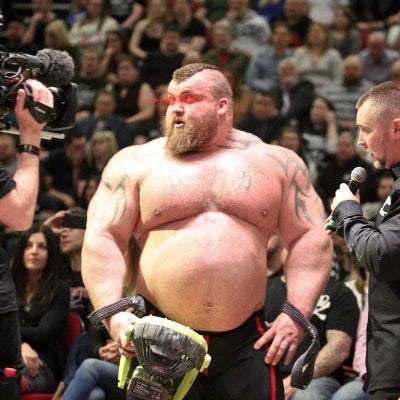One of the common issues that trips people up when it comes to sport-specific training is the observation that powerlifters and strongmen don’t run the fastest, don’t jump the highest, and aren’t the most agile athletes in the world.
If strength is so good at improving those things, the argument goes, why are the strongest people in the world not even close to the fastest, most agile, or most explosive?
The answer of course, is a lesson from the economists: ceteris paribus. The latin phrase means “other things equal," and was popularized after its use by John Stuart Mill and Alfred Marshall in the 19th century. The idea is not that the stronger athlete will always be faster than the weaker: does anyone think Eddie Hall in his bloatlord phase when he got his bodyweight up over 400 lbs in order to be the first human to ever deadlift 500kg, would beat Usain Bolt in a 100m footrace? I hope not.

The idea is that the same athlete will be faster and jump higher if he is stronger, all else held roughly equal. Powerlifters and strongmen gain a ton of bodyweight to maximize their strength, and also focus on the positions and skills needed to excel in their sport, which at the highest levels of specialization, trades off for lower capacity in other domains like sprinting or leaping.
But take a sprinter and make him strong, without gaining too much weight, and all else held equal, he will be faster.
The clearest demonstration of this is comparing sprinters not to Eddie Hall but to other runners - marathon runners - who do not need to go as fast as possible, but to last as long as possible at a slower speed. Usain Bolt reached speeds as high as nearly 28mph for a short maximal burst. World class marathon runners maintain a pace of 12-13mph for 26 miles. What does this difference in specialization look like?
Why does each look the way they do? What’s all that muscle for? Obviously it’s for the purposes of force production, so each step can propel the sprinter with greater force, making him go faster.
If you don’t have it, what’s the best way to develop it? The same way as the best way for anyone else to develop strength: Barbell lifts that use the most muscle mass, over the longest effective range of motion, in a way that allows you to use the most weight, and thus get stronger. The squat, deadlift, press, bench press, power clean, power snatch.
This doesn’t mean those are the ONLY things sprinters should do. At the specialized top level, they may do lots of specialized training too. And those guidelines aren’t absolute rules, but heuristics that give us a starting point for the best way to build your base, whether you’re a sprinter, running back, or 45 year old dad who wants to get in shape. A sprinter who has already built his base and is strong, will undoubtedly do other things than the basic barbell lifts as well.
But the base is the base, and the muscular physiques that sprinters have, as opposed to their marathon runner counterparts, tell us that strength and force production are vital to their success in sport, and are an important part of why they run twice as fast as the marathoners.
So the proper comparison isn’t 430 lb Eddie Hall vs Usain Bolt. It’s a sprinter vs a marathon runner.






I run into the same problem when I tell people that more muscle mass will make them look better. "BUT I DON"T WANNA BE A FAT POWERLIFTER!" I try to explain that turning into a fat powerlifter is almost entirely a matter of diet, but such subtleties are lost. Images on the internet are just too powerful.
"I wouldn’t want to make him mad, but I’m pretty sure I could’ve successfully out-run him if I did, when he weighed well over 400 lbs here."
You wouldn't want to guess wrong, that's for sure. Or trip.